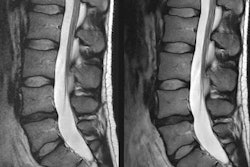
The body composition of patients hospitalized for COVID-19 as assessed on routine abdominal CT exams could help predict adverse outcomes, according to research published online July 9 in the International Journal of Obesity.
In a retrospective study involving more than 100 patients, researchers led by Katherine Bunnell from Massachusetts General Hospital (MGH) found that two body composition measures -- elevated visceral adipose tissue and intermuscular adipose tissue -- were associated with intensive care unit (ICU) admission and death.
"With further investigation into the generalizability and predictive power of this finding, body composition measures could serve as novel biomarkers of outcome in patients with COVID-19," the authors concluded.
When admitted to the hospital, COVID-19 patients often receive abdomen or chest CT exams as a result of their clinical care. In this study, the researchers sought to determine the value of body composition metrics on abdominal CT scans for evaluating a patient's risk of admission to the ICU and death. These CT exams could be opportunistically used to assess body composition without incurring additional costs or radiation exposure, according to the researchers.
Bunnell and colleagues retrospectively analyzed 124 patients who had been hospitalized at MGH for COVID-19 between March 11 and May 31, 2020, and had received an abdominal CT scan for clinical purposes within two months of admission. Of these patients, 50 later were admitted to the ICU or died over a median time of one day from being admitted to the hospital.
All CT exams were performed on a 64-slice or 128-slice multidetector-row CT scanner (Siemens Healthineers or GE Healthcare). A supervised automated algorithm developed at MGH was then used to measure cross-sectional areas of abdominal subcutaneous adipose tissue, visceral adipose tissue, intermuscular adipose tissue, and paraspinal and abdominal muscle.
The visceral adipose tissue/subcutaneous adipose tissue ratio was used to assess the relative distribution of abdominal adipose tissue. In addition, body composition measurements were standardized by subtracting the mean of each measurement and dividing by the standard deviation, according to the researchers.
Next, they utilized risk models to estimate the hazard ratio for a composite outcome of ICU admission or death associated with a one standard deviation increase in each body computational measure. The models were also adjusted for factors such as age, sex, race, body mass index, and cardiometabolic comorbidities.
The researchers found that, independent of other established prognostic factors, the visceral adipose tissue/subcutaneous adipose tissue ratio and intermuscular adipose tissue were associated with an increased risk of ICU admission or death in these COVID-19 patients.
| Body composition metrics that predict adverse outcome in COVID-19 patients | ||
| Metric | Hazard ratio for ICU admission/death | p-value |
| Higher intermuscular adipose tissue cross-sectional area | 1.44 | 0.008 |
| Higher visceral adipose tissue/subcutaneous adipose tissue ratio | 1.30 | 0.022 |
The researchers noted that their automated algorithm was able to easily quantify fat compartments, as well as paraspinal and abdominal muscle areas.
"The impact of routine assessment of body composition using opportunistic CTs performed for clinical purposes should be evaluated to provide additional information on prognosis in patients with COVID-19 undergoing CT," they wrote.




















